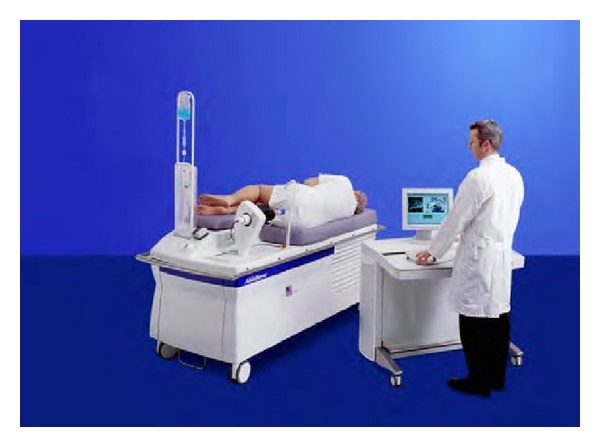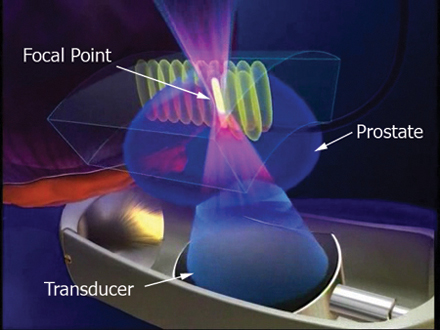
High Intensity Frequency Ultrasound Treatment (HIFU)
HIFU is a type of cancer treatment. Doctors give the treatment using a machine that gives off high frequency sound waves. These waves deliver a strong beam to a specific part of a cancer. Some cells die when this high intensity ultrasound beam is focused directly onto them.
HIFU, which is short for High Intensity Focused Ultrasound, is a state-of-the-art technology acoustic ablation technique that utilizes the power of ultrasound to destroy deep-seated tissue with pinpoint accuracy for treatment of prostate cancer. HIFU focuses sound waves in a targeted area which rapidly increases the temperature in the focal zone causing tissue destruction.
In most cases, HIFU is a 1-4 hour, one-time procedure performed on an out-patient basis under spinal anesthesia. Unlike radiation, HIFU is non-ionizing; this means that HIFU may also be used as a salvage technique if other prostate cancer treatments fail.
HIFU is an outpatient procedure generally performed under local or general anesthesia that is completely radiation free. Because HIFU is non surgical, there is no incisions or blood loss and recovery is quick. HIFU therapy can be repeated, if necessary. It can also be used as a salvage therapy if other prostate cancer treatment options fail. Because it uses clean, ultrasound energy it doesn't cause harm to any tissue surrounding the targeted focal point.
Gamma knife is a type of stereotactic radiosurgery that uses strong doses of gamma radiation to treat the part of the brain suffering from the disease. The radiation though powerful, is precise enough that it does not cause any harm to the surrounding healthy brain tissue. It is meant to target only the diseased brain cells.
The gamma knife surgery is effective in treatment of the brain tumours which can be benign or cancerous. It is also widely used for treating the arteriovenous malformations (AVMs) in the brain and other neurological dysfunctions like trigeminal neuralgia.
Gamma knife radiosurgery is a non-invasive and non-surgical procedure as it does not involve any cutting of the tissue and is highly advanced method of radiation therapy that emits high energy beam of gamma radiation to effectively kill the small tumours.
The deep tumours, blood vessel abnormalities and other nervous system problems which neuro surgeons found difficult to tackle with the scalpel due to their location or posed high risk to the patient can now be treated with gamma knife surgery. It has thus given a new hope to patients suffering with brain tumours, Arteriovenous malformations and other functional
HIFU has fewer risks than surgery, so it might be suitable for men with other health problems
You only need a short hospital stay - less than 24 hours.
HIFU may be an option if the cancer comes back after treatment with external beam radiotherapy (EBRT). This isn't the case with all treatments.
HIFU can be carried out as a day case; you will be admitted for treatment early in the morning and will usually be able to leave hospital later the same day. Other more radical treatments usually require several days in hospital.

Following steps are included in HIFU procedure for Prostate cancer Treatment:
• Since it is necessary that all your movement be minimized during the treatment, spinal anesthesia is administered as well as intravenous sedation so you will rest comfortably during the procedure.
• The treatment may last anywhere from 2 to 3 hours depending on the size of your prostate. The treatment is performed with you lying on your right-hand side.
• The urologist inserts a small probe into the rectum after coating it with gel and placing it inside a latex balloon filled with a cooling liquid. This maintains a constant temperature in the rectal wall during the entire treatment.
• The urologist locates the limits of the prostate by ultrasound examination and outlines the zone he wishes to treat. Then 400 to 600 pulses of high-intensity focused ultrasound are administered to the prostate. As a result of the treatment the prostate swells immediately and compresses the urethra. For this reason, a temporary catheter is inserted into the bladder to drain urine until the swelling of the prostate goes down. Generally, the catheter will be required to stay in place for 14 days.
• If you have an enlarged prostate with symptoms or signs of prostatic obstruction (i.e. weak urinary stream, frequent urination at night, or sensation of residual urine volume in the bladder), you may need to have the prostate reduced prior to treatment. This is usually done by the use of medication (cyto-reduction) or by having part of your prostate resected prior to having the treatment. This procedure is called a transurethral resection of the prostate (TUR-P).
Before HIFU Treatment
Patients are given two enemas two hours prior to the procedure. It is very important that the patient does not move during HIFU thus patients are given a light intravenous sedation and a spinal anesthesia.
During HIFU Treatment
There is no pain during treatment, A small probe inserted into the rectum emits ultrasound waves directly to the prostatic tissue. During the procedure, the Sonablate delivers real-time images of the prostate and the surrounding area giving the physician immediate and detailed feedbakc.Treatment time varies but generally lasts one to four hours depending on the size of the prostate.
After HIFU Treatment
Immediately after HIFU there is a one to two hour recovery period at the treatment facility and then you are discharged. Recovery is minimal. A catheter is inserted during the procedure that is usually worn for one to four weeks. People usually are up and walking around within hours after HIFU and can return to a normal lifestyle within a couple of days.


Mr.Gilbert, Knee Replacement, Nigeria
Mr.Gilbert from Aba, Nigeria who came to India for his knee replacement in India.
Mrs. Kalangwa George, Lung Cancer, Kenya
Mrs. Kalangwa George from Mombasa, Kenya who came to India for her Lung Cancer Treatment in India.
Mrs. Elisabeth, Breast Cancer Surgery, Nigeria
Mrs. Elisabeth from Kano, Nigeria who came to India for the Breast Cancer Surgery.
Mr.Tselmeg, Kazakhstan, Spine Surgery
Mr.Tselmeg from Astana, Kazakhstan who came to India for the Spine Surgery
Mr. Stephen Okafor, Spine Surgery, Nigeria
Mr. Stephen Okafor from Onitsha, Nigeria who came to India for the Spine Surgery
Mrs. Asiata Nofiu, Laparoscopic Ovarian Cystectomy , Nigeria
Mrs. Asiata Nofiu from Lagos, Nigeria who came to India for the Laparoscopic Ovarian Cystectomy
Mr. Alhassan Osman, Prostate Treatment, Tanzania
Mr. Alhassan Osman from Mwanza, Tanzania who came to India for the Prostate Treatment
Mr. Okubowa Babatunde , Heart Surgery , Zimbabwe
Mr. Okubowa Babatunde from Harare, Zimbabwe who came to India for the heart hole surgery